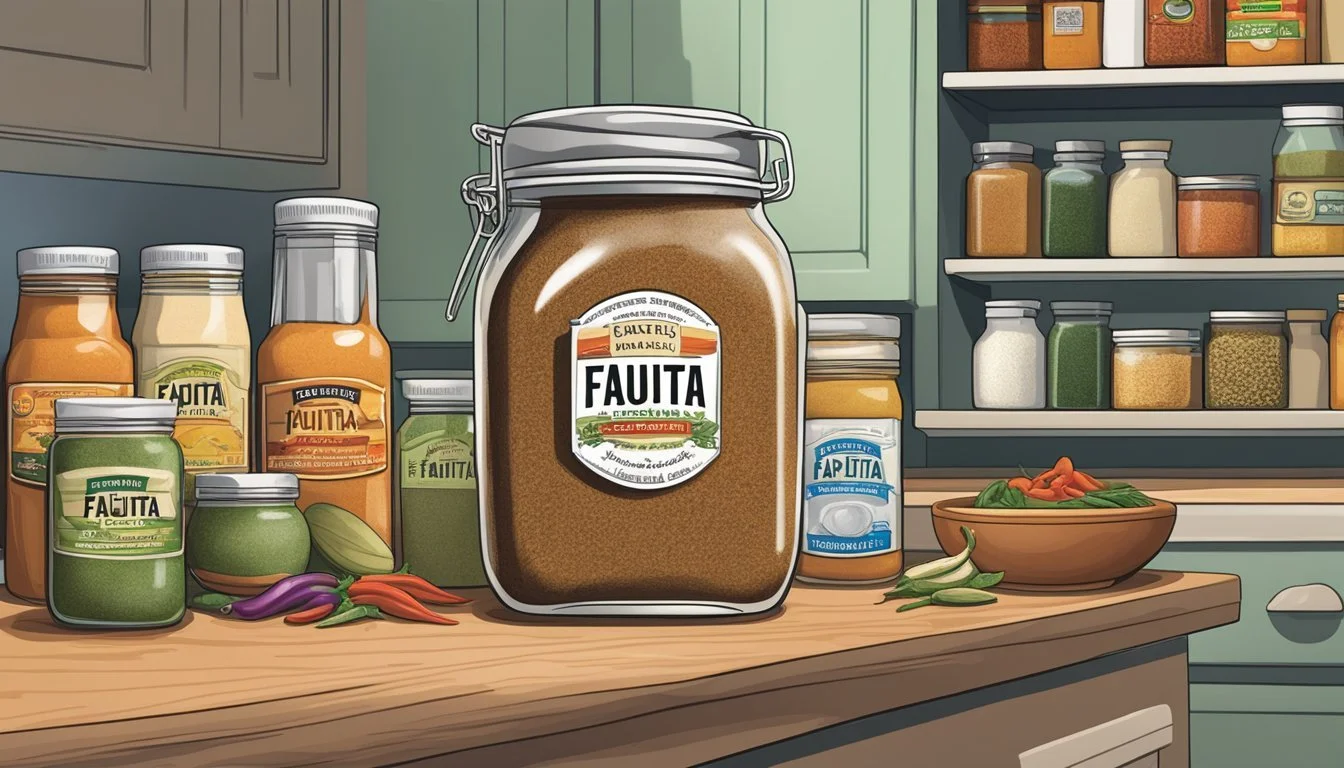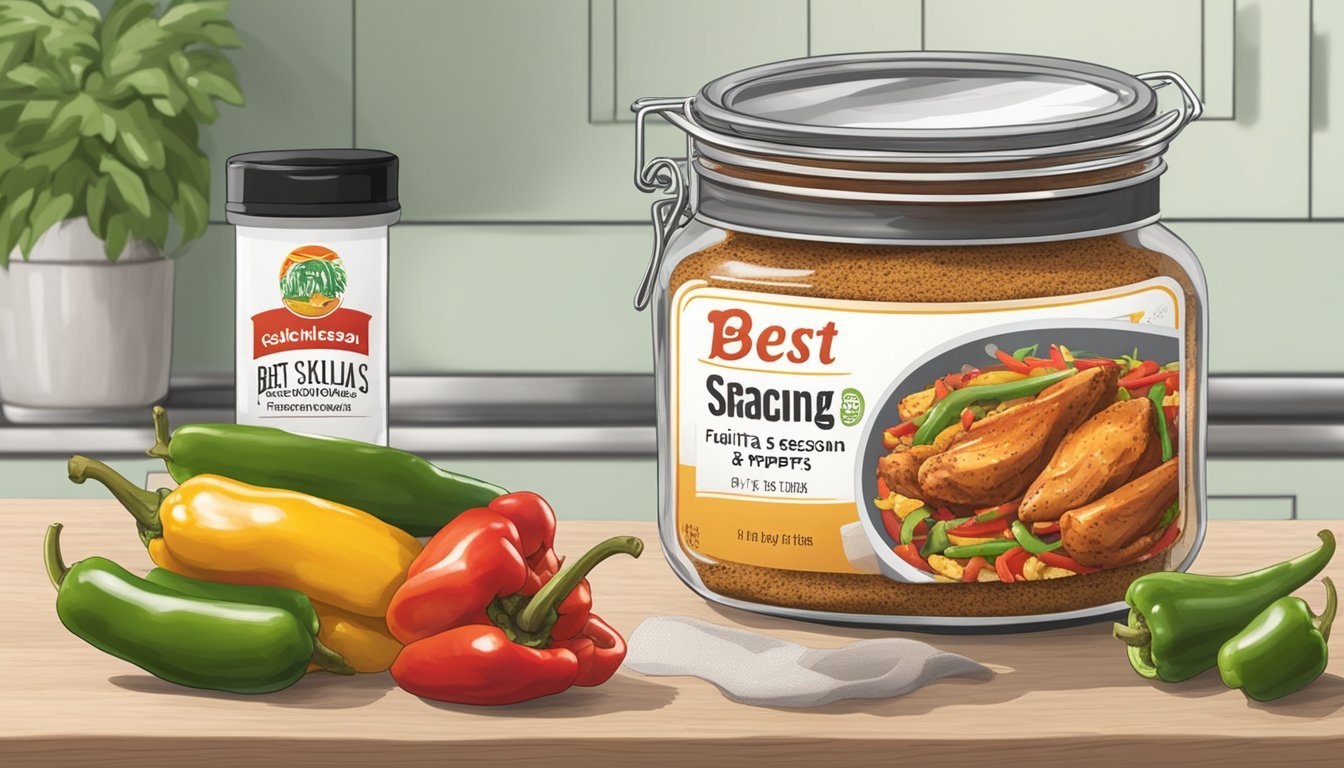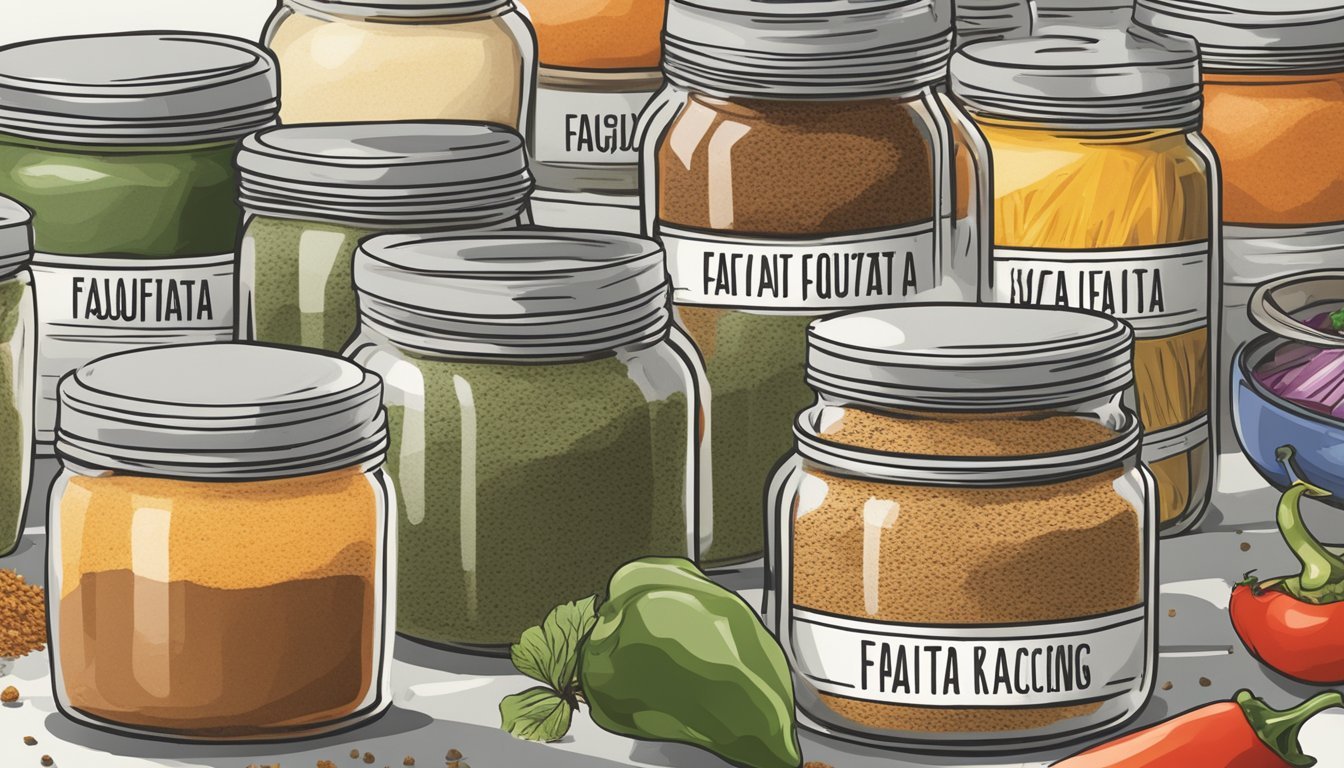How Long Does Fajita Seasoning Last?
Shelf Life and Storage Tips
Fajita seasoning (how long does fajita seasoning last?) is a blend of spices commonly used to impart a Tex-Mex flavor to various meats and vegetables. The shelf life of fajita seasoning can vary depending on a number of factors, such as the type of ingredients involved, whether the seasoning is homemade or store-bought, and the conditions under which it is stored. Generally, a store-bought fajita seasoning can be expected to retain its optimal flavor for about six months when kept in a cool, dry place away from direct sunlight and moisture.
Homemade fajita seasoning, made by combining spices like chili powder, cumin, garlic powder, (how long does garlic powder last?) and others, may have a similar shelf life to commercial blends. However, without the preservatives that are sometimes found in pre-packaged seasonings, the homemade variety could potentially lose its potency more quickly. To ensure maximum flavor, homemade fajita seasoning should be stored in an airtight container to minimize exposure to air and humidity, which can lead to clumping and flavor degradation.
For both homemade and store-bought fajita seasoning, the freshness can be maintained by storing in airtight containers and keeping them in a consistently cool and dark environment, like a pantry. Though the seasoning may still be safe to consume after the six-month mark, the intensity of the flavor is likely to diminish over time. Regularly checking the aroma and taste before use can help gauge if the seasoning still has the desired impact for cooking.
Fajita Seasoning Overview
In the realm of Tex-Mex cuisine, fajita seasoning plays a crucial role in adding depth and flavor to a variety of dishes. This blend of spices is designed to complement the savory notes of grilled meats and vegetables typically found in fajitas.
Ingredients Breakdown
The foundation of fajita seasoning is built upon a combination of key spices that includes chili powder, paprika, cumin, salt, garlic powder, and onion powder (how long does onion powder last?). Each ingredient contributes to the overall taste profile:
Chili powder delivers warmth and a mild to moderate heat.
Paprika, often made from ground bell and chili peppers, provides a sweet-smoky note.
Cumin offers an earthy, nutty essence.
A balance of salt enhances the individual flavors of the components.
Garlic powder and onion powder add a pungent depth that underlines the seasoning's bold character.
Homemade vs Store-Bought
While store-bought fajita seasoning is conveniently pre-mixed and has a typical shelf life of around 6 months, homemade variants offer a freshness and the ability to tailor the spice levels to individual preferences. Homemade seasoning, if stored properly in a cool, dry place, also retains potency for up to 6 months. The difference in taste between the two can be significant, with homemade blends often providing a more robust and authentic flavor without any additives or preservatives.
Common Uses in Recipes
Fajita seasoning isn't just for fajitas; it's a versatile mix that enhances a variety of Tex-Mex dishes. It can be used as a dry rub for proteins such as beef, chicken, or shrimp, and can also be mixed with oil or water to create a marinade. The seasoning pairs exceptionally well with sautéed onions and bell peppers, which are the traditional vegetable accompaniments in fajita dishes. It may also be applied to enhance tacos, burritos, or grilled vegetables, proving its utility beyond its namesake.
Making Your Own Fajita Seasoning
Creating a homemade fajita seasoning is simple and allows for customization to the chef's taste preferences, particularly in terms of heat and flavor intensity. The following subsections break down the components and steps necessary to achieve a flavorful seasoning mix.
Choosing the Right Spices
The foundation of any fajita seasoning is a well-chosen array of spices. Quality ingredients yield better flavor. Chili powder provides the base with a requisite earthy tone and should be fresh for maximum impact. Cayenne pepper adjusts the heat level; a little goes a long way. Oregano imparts an aromatic touch and is typically used dried for convenience and concentrated flavor.
Mixing for Optimal Flavor
Combining spices in the right proportions is crucial for a well-balanced fajita mix. Each spice should be measured carefully and mixed thoroughly to ensure that each ingredient can shine without overpowering the others. It's recommended to taste and adjust accordingly, especially with potent spices like cayenne, which can quickly increase the heat level of the seasoning.
Recipe for Homemade Fajita Seasoning
Here is a concise recipe for a homemade fajita seasoning:
2 tbsp chili powder
1 tbsp paprika
1 tbsp garlic powder
1 tbsp onion powder
1 tbsp ground cumin
1/2 tbsp dried oregano
2 tsp sea salt (how long does sea salt last?)
1 tsp ground black pepper
A pinch of cayenne pepper (optional for added heat)
Mix all the ingredients in a bowl until well combined. Store the seasoning in an airtight container to preserve freshness and flavor.
Shelf Life of Fajita Seasoning
The typical shelf life of fajita seasoning ranges from six months to two years, highly influenced by storage conditions and whether the mix is store-bought or homemade.
Storage Best Practices
Storing fajita seasoning in an airtight container is crucial for maintaining its potency and preventing contamination. Placement in a cool, dry place away from heat sources ensures that the seasoning retains its original flavor and consistency.
Airtight container: essential to prevent moisture and air from altering the seasoning's quality.
Cool, dry place: preserves the seasoning's freshness and prevents caking or clumping due to humidity.
Signs of Spoilage
Visual and olfactory inspection can identify if the seasoning has spoiled:
Color change: A pronounced dullness or change in color may indicate spoilage.
Odor: Loss of aroma or an off-smell can suggest the seasoning is past its prime.
Extending Freshness
To prolong the lifespan of fajita seasoning:
Homemade blends: Freshly ground spices maximize longevity, approximately six months if properly stored.
Commercial blends: Can last up to two years; always check expiration dates as a guideline.
Culinary Applications
Fajita seasoning is a versatile blend that enhances flavor profiles of various proteins and vegetables, offering a bold taste to numerous dishes.
Meat and Vegetables Pairings
When utilizing fajita seasoning in the kitchen, chefs often pair it with proteins like chicken, steak, and shrimp, which are traditional choices for making chicken fajitas. Additionally, an array of vegetables compliments these proteins, including but not limited to onions, bell peppers, and more exotic options like zucchini or mushrooms. A simple guideline for seasoning is:
Proteins: about 1 tablespoon of fajita seasoning per pound.
Vegetables: to taste, usually a light sprinkle.
The seasoning should be added during the cooking process to allow the flavors to meld and the vegetables to achieve a slight caramelization.
Alternative Uses Beyond Fajitas
Fajita seasoning's application extends beyond the namesake dish. It can infuse a delicious depth of flavor to other culinary creations such as:
Chili and casseroles
Soups and rice dishes
Seafood
Chefs may mix fajita seasoning with oil or water to create a marinade, enhancing the taste profile of dishes. A standard marinade ratio would be:
¼ cup of oil (like canola or olive)
2 tablespoons of fajita seasoning
Let the protein marinate for at least 30 minutes before cooking to ensure the flavors are fully absorbed.
Nutritional Information
The nutritional value of fajita seasoning is determined by its individual spices. This section breaks down the nutritional content of those spices and considers dietary impacts.
Spices Nutritional Content
Spices contribute minimal calories to a diet but can be rich in vitamins and minerals. A breakdown of key spices commonly found in fajita seasoning shows:
Chili powder: Rich in vitamin A and minerals like potassium and iron.
Cumin: Contains iron, which is essential for blood health.
Oregano: Offers fiber, iron, calcium, and vitamin A.
Garlic powder: Provides a small amount of potassium and fiber.
Onion powder: Contains calcium and potassium.
It is important to note that seasonings are used in small amounts, so their contribution to the total daily intake of these nutrients will be minor.
Impact on Dietary Considerations
When considering fajita seasoning within a dietary context, one should account for:
Calories: Spices add insignificant calories to meals.
Carbohydrates: Present in small amounts, primarily as fiber.
Fat: Generally have negligible fat content, including saturated fat.
Nutrition: Can offer a range of micronutrients as highlighted above.
Individuals with specific health considerations, such as the need for low-sodium diets, should carefully read the labels of store-bought fajita seasonings or make their own to control the amount of added salt.
Purchasing and Quality Evaluation
When buying fajita seasoning, consumers should focus on finding high-quality mixes and understanding the labels to ensure freshness and flavor potency.
Identifying High-Quality Seasoning Mix
The quality of a fajita seasoning mix can significantly affect the flavor and outcome of a dish. Consumers should look for mixes that feature bold and vibrant colors, indicating freshness. Overly powdery or clumpy textures may suggest exposure to moisture or age. A high-quality mix often boasts a potent aroma, suggesting that the essential oils within the spices are still intact and active. The presence of preservatives in a seasoning mix can indicate a longer shelf life, although some consumers might prefer preservative-free options for a more natural product.
Reading Labels and Ingredient Lists
An essential part of purchasing fajita seasoning is understanding labels and ingredient lists. Consumers should check for an expiration date to guarantee the seasoning's potency is within its peak. They should also examine the ingredient list for fillers or unnecessary additives that may dilute the flavor. The best lists are short and comprised of recognizable ingredients, indicating a purer product.
Ingredients to look for: Authentic spices such as cumin, chili powder, garlic powder, and onion powder.
Avoid: Unusual additives or a long list of ingredients that do not contribute to the flavor profile.
Check for affiliate links when purchasing online, as these can sometimes lead to deals or higher quality options vetted by culinary experts.
A careful evaluation of the quality and labeling of fajita seasoning mix will ensure a consumer's cooking experience will yield the most flavorful results.
Comparing Fajita Seasoning with Other Mixes
Fajita seasoning has a distinct flavor profile designed specifically for fajitas. However, its usage can overlap with other seasoning mixes based on the ingredients involved.
Fajita vs Taco Seasoning
Fajita Seasoning: Primarily contains chili powder, ground cumin, garlic powder, paprika, salt, and pepper. It’s crafted to complement the grilled flavor of fajita meats and vegetables, providing a balance of heat and savory notes.
Taco Seasoning (how long does taco seasoning last?): While similar, taco seasoning often has a higher concentration of chili powder and may include additional ingredients like red pepper flakes (how long do red pepper flakes last?) and oregano. It's formulated to give ground meat or vegetarian alternatives the classic taco flavor.
Taco and fajita seasonings are somewhat interchangeable, but one should note the difference in the heat level and subtle flavor nuances that may affect the final dish.
Substitutes and Alternatives
Cajun Seasoning: This Louisiana-origin mix is bolder, with a complex array of spices that include onion powder, thyme, and sometimes cayenne for extra heat. It’s not traditionally interchangeable with fajita seasoning but can be used for a different flavor profile.
Italian Seasoning: It’s a blend of dried herbs such as basil, oregano, rosemary, thyme, and marjoram. Italian seasoning imparts an aromatic, herbaceous character to dishes. It varies considerably from fajita seasoning and is not an ideal substitute for a Mexican-inspired dish.
Recipes Featuring Fajita Seasoning
Fajita seasoning enhances the flavor profile of various dishes beyond traditional fajitas. From the classic chicken fajita recipe to innovative culinary creations, fajita seasoning adds zest to meat, seafood, and vegetables.
Classic Chicken Fajita Recipe
Ingredients:
Chicken breasts, sliced into strips
Bell peppers, assorted colors, sliced
Onion, thinly sliced
Fajita seasoning: typically a blend including chili powder, salt, paprika, sugar, onion powder, and garlic powder
Flour tortillas
Optional toppings: sour cream, cheese, salsa
Instructions:
In a bowl, toss the chicken strips with the fajita seasoning until they're evenly coated.
Heat oil in a skillet and sauté the chicken until it’s tender and cooked through.
Remove the chicken, and in the same skillet, cook the peppers and onions until they're soft and slightly charred.
Serve the sautéed chicken and veggies wrapped in warm flour tortillas with optional toppings such as cheese, salsa, and sour cream.
Innovative Dishes Using Fajita Seasoning
Taco Soup: A hearty blend of beans, corn, tomatoes, ground beef or turkey, and fajita seasoning simmered to perfection, topped with crunchy tortilla strips and fresh cilantro.
Fajita-Seasoned Rice: White or brown rice sautéed with fajita seasoning, a mix of fajita veggies, and a squeeze of lime juice for a flavorful side dish.
Seafood Delight: Shrimp or other seafood marinated in fajita seasoning, then grilled or sautéed and served with a cilantro-lime rice or tucked into gluten-free tacos.
Steak Fajitas: Skirt or flank steak rubbed with fajita seasoning and grilled until juicy, accompanied by a colorful array of sautéed fajita veggies.
Burrito Bowls: A base of rice topped with fajita-seasoned chicken or beef, black beans (how long do black beans last?), fresh veggies, and a dollop of guacamole for a filling, customizable meal.
FAQs About Fajita Seasoning
When considering the various aspects of fajita seasoning from shelf life to preparation, it's important to address common inquiries for optimal use and enjoyment.
Adjusting Heat and Flavor
To modify the heat level of fajita seasoning, adjust the amount of cayenne pepper or chili powder. For more flavor without the heat, increase the use of herbs and spices like onion powder and oregano. Personal taste preferences can guide the proportions.
Double Batch Preparation
When making a double batch of fajita seasoning, ensure consistency by thoroughly mixing all ingredients. Store the seasoning in an airtight container to maintain freshness. The seasoning can last up to 6 months when stored in a cool, dry place.
Allergen Information
Fajita seasoning may contain allergens depending on the ingredients used. Always check labels for potential allergens like gluten, which can be present in additives. Homemade blends allow full control over the ingredients, making it easier to avoid specific allergens.









